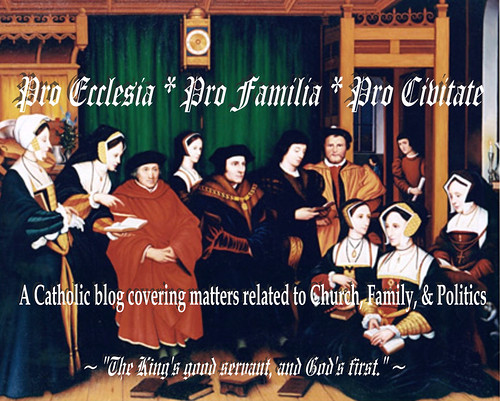May, the Month of Mary (Part 2)
.jpg)
From the Medieval Saints Yahoo Group:
May Coronation of Mary
The Church and the faithful referred to Mary as queen since the fourth century.
Instituted ?
Commemoratation held during the month of May
"A great sign appeared in the sky, a woman clothed with the sun, with the moon under her feet and on her head a crown of twelve stars."
~ Revelations 12:1
The beginning of the concept that Mary is a Queen is found in the annunciation narrative. For the angel tells her that her Son will be King over the house of Jacob forever. So she, His Mother, would be a Queen.
The Fathers of the Church soon picked up these implications. A text probably coming from Origen (died c. 254: cf. Marian Studies 4, 1953, 87) gives her the title domina, the feminine form of Latin dominus, Lord. That same title also appears in many other early writers, e.g. , St. Ephrem, St. Jerome, St. Peter Chrysologus (cf. Marian Studies 4. 87-91). The word "Queen" appears abut the sixth century, and is common thereafter (Marian Studies, 4, 91-94).
http://www.ewtn.com/faith/teachings/marya6.htm
The offering of crowns to adorn images became common practice in the Eastern Churches. In itself it would mean no more than adding such additional splendor to the icon as might also be given by a handsome gold frame. Then the affixing of the crown naturally attracted to itself, like all things dedicated to the use of the Church, was blessed before it was affixed.
http://www.wf-f.org/MayCrowning.html
Since medieval times, we have the combination between Mary and the month of May. Among the earliest witnesses are: Alphonsus X, "el sabio", King of Castille, Spain (1221-1284) with his "Cantigas de Santa Maria" ("Ben venna Mayo"). Here and elsewhere, both Mary and the month of May are greeted, welcomed and celebrated on specific days in May. Later, the whole month of May became the month of Mary. On each day of this month, special devotions to Mary were organized. At Rome, too, a ceremony evolved out of this pious practice. A famous case is the coronation of the picture of our Lady in Saint Mary Major. Clement VIII (1592-1605) presented crowns (one for our Lord and one for His Mother) to adorn it; so also did succeeding popes.
http://www.udayton.edu/mary/meditations/crownmed.html
Popular Devotion: May Devotions
Excerps from the book "Popular Devotions" by Rev. Fr. Bernhard Rass, SVD
http://www.geocities.com/barats2000/May.html
HOW DID THE MONTH OF MAY BECOME A MARIAN MONTH?
May is the month of blossoms, flowers and new life
This can be understood on the background of the seasons of the year in Europe where the practice of celebrating May as month of Mary began. During the winter season nature seem to be dead; it is very cold, snow covers the earth, the trees are bare, no leaves, no fruits and no flowers can be seen except on indoor plants. With the spring season, nature comes to life gain; the trees develop fresh green leaves, flowers begin to sprout everywhere and the season of planting has come. In April to May the trees begin to blossom promising a good and rich harvest in autumn. It is therefore quite a contrast: winter as a symbol of death, spring as a symbol of new life, a rising from the death; winter a season of bareness and cold, and spring the season of beautiful flowers promising new life. To celebrate this May festivities are going on everywhere especially in rural areas.
The lovely month of May was brought in relationship to Mary. She is the most beautiful flower and creature of God, through her God brought salvation and life to the world. May-meditations of the past two centuries are full of descriptions of the beauty of Mary, how God elected her and prepared her to be a worthy Mother of God. The analogy between flower and Mary is wide open for the christological dimension of Marian devotion. While the blossoms are beautiful to look at and a value in themselves, their real purpose is to bring about a fruit. Applied to Mary this would mean her beauty must always be seen in relationship to the fruit she brought forth Jesus Christ. Unhappily this Christ dimension was sometimes neglected in May-devotions; the whole attention was given to the blossom, while the fruit coming forth from the blossoms remained secondary.
May is the month of the Easterseason
The Church gives us fifty days to celebrate and to reflect the effects of the Paschal Mystery: our redemption in and through Jesus Christ. During Easter season we meditate about the power of the Risen Lord who made of us a new creation and heirs of the kingdom. In a special way, we look at the most perfectly redeemed one, Mary. The month of May as Marian month shows the connection between Mary and Easter, between the mother and the redemptive work of her Son. All the beauty and perfection of Mary comes from the salvific action which the Church celebrated in the Pascal Triduum.
Comparison between Maia and Maria
The month of May derives its name from Maia, the goddess of spring. According to Greek mythology she was the daughter of Atlas and Pleione and the mother of the messenger-god Hermes. Especially during the planting season, sacrifices were offered to her to petition for a good harvest. It is easy to make a comparison between Maia and Mary. As Maia was the mother of the messenger-god Hermes, Mary was the mother of the Messenger-God Jesus Christ. As the month of May was dedicated to Maia, the Christians began to dedicate this month Mary. As to Maia were offered sacrificial offerings, so the Christians began to honor Mary with floral offerings.
------------------------------

Previous Pro Ecclesia posts on this subject:
May, the Month of Mary (Part 1)
Labels: Devotionals, Our Blessed Lady



0 Comments:
Post a Comment
<< Home